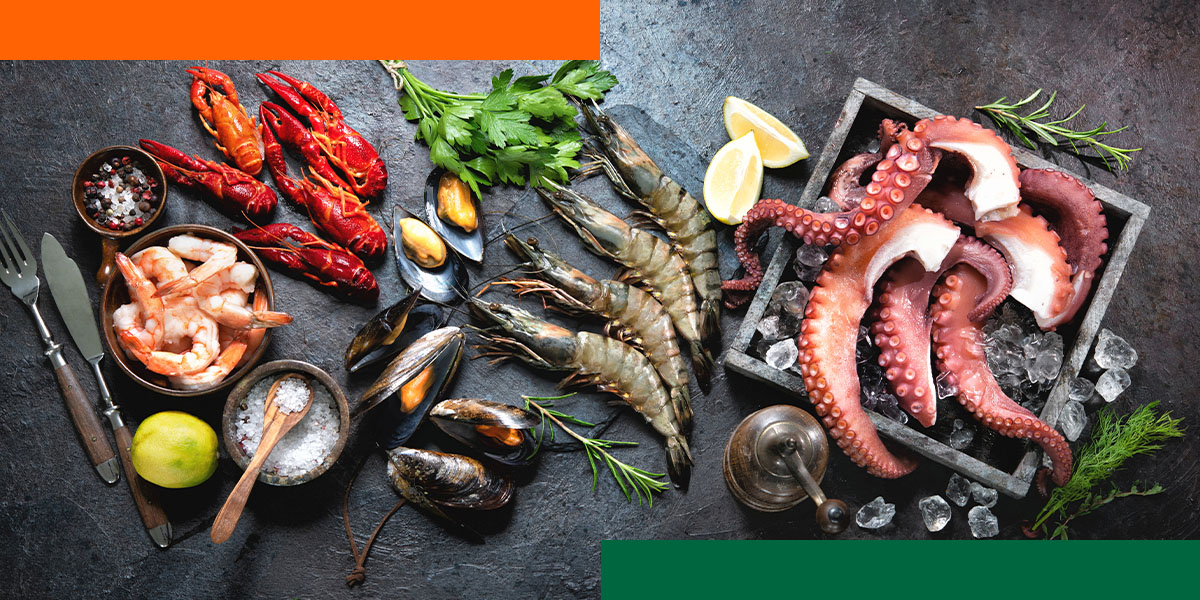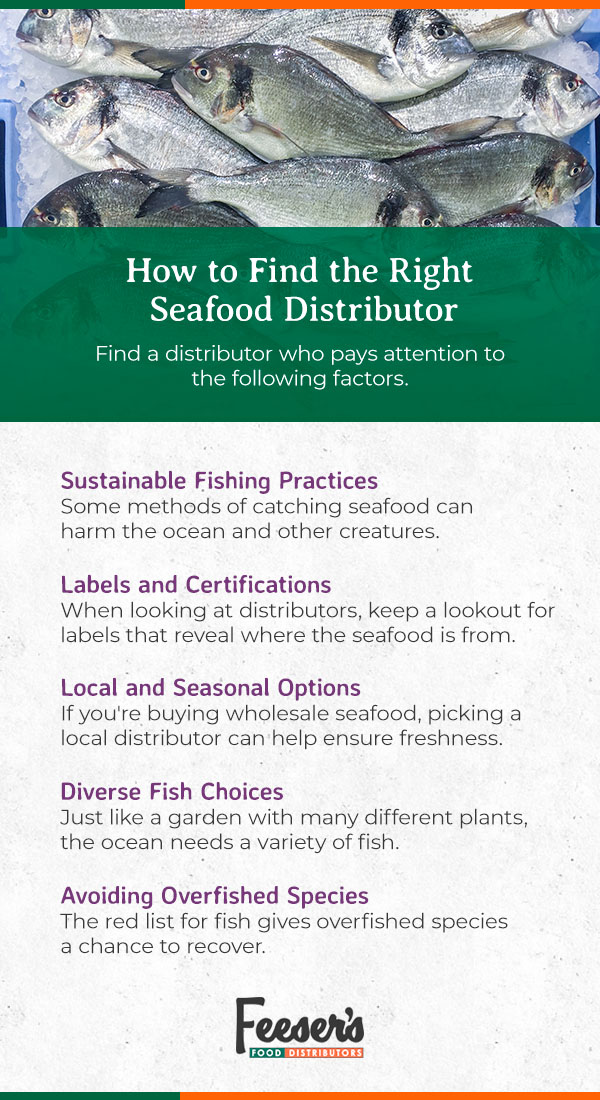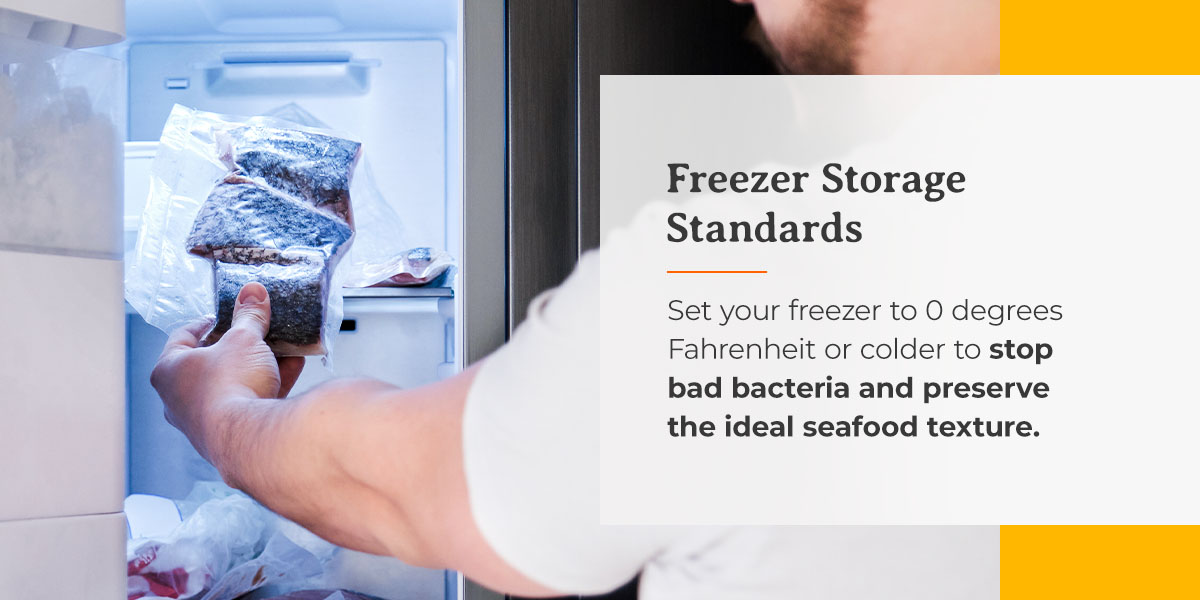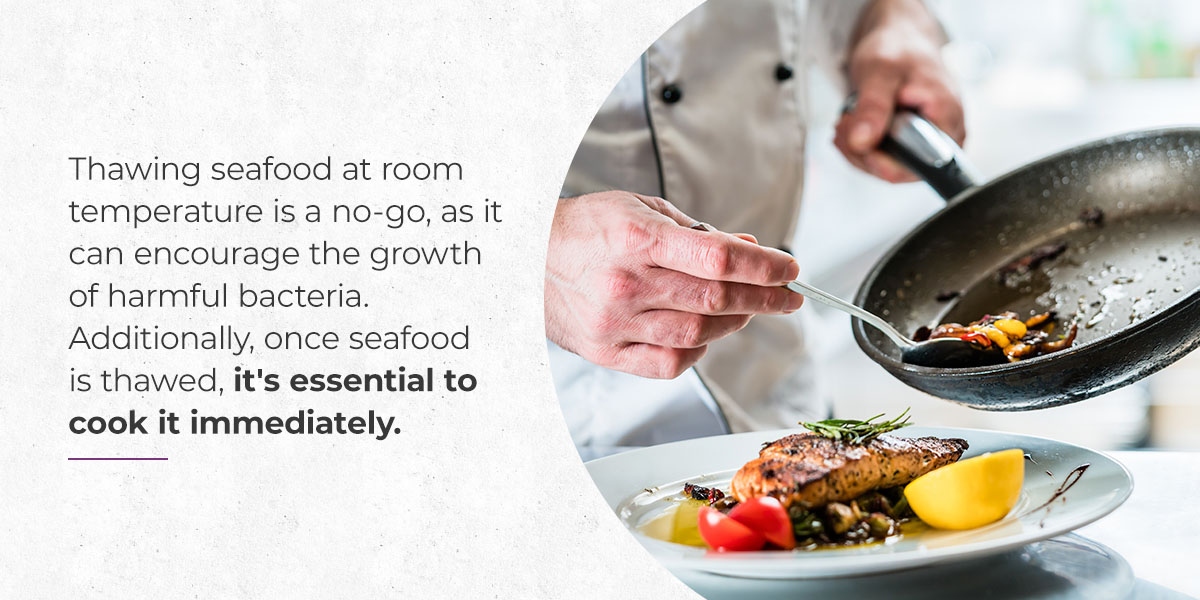Seafood Guide: Sourcing, Storing and Serving
Few things are as enticing as a beautifully prepared seafood dish. From the delicate flavors to the exquisite textures, seafood offers a symphony of tastes that captivate the senses. As someone who sources seafood from a distributor, there are some things to consider before you can deliver delicious seafood meals to customers. Seafood’s perishable nature demands a level of attention like no other. The journey from sourcing to serving is intricate and requires careful steps.
Proper seafood handling isn’t just a matter of culinary artistry — it’s a responsibility to safety and excellence. With each bite, a delicate balance must be maintained to preserve the seafood’s quality, flavor and safety. There are a few secrets behind sourcing, storing and serving seafood. Read on to learn them.
How to Find the Right Seafood Distributor
Sourcing seafood for a restaurant involves securing fish and other sea creatures for customers to eat. You can find a distributor who pays attention to the following factors.
Sustainable Fishing Practices
Some methods of catching seafood can harm the ocean and other creatures. Finding a distributor who uses methods like lines and traps instead of big nets helps keep the ocean’s balance intact.
Labels and Certifications
When looking at distributors, keep a lookout for labels that reveal where the seafood is from. Labels such as MSC (Marine Stewardship Council) and ASC (Aquaculture Stewardship Council) indicate seafood caught or raised in ways that don’t hurt the ocean or marine life.
Local and Seasonal Options
If you’re buying wholesale seafood, picking a local distributor can help ensure freshness. It also reduces pollution caused by shipping seafood across long distances.
Diverse Fish Choices
Just like a garden with many different plants, the ocean needs a variety of fish. If everyone eats only one kind of fish, it might disappear. Sourcing different types of seafood helps maintain a healthy ocean balance.
Avoiding Overfished Species
Some fish are in danger because people catch too many. Finding a distributor who avoids these fish and follows the red list for fish gives overfished species a chance to recover. This helps keep the ocean’s delicate ecosystem in check.
Stay curious and keep learning about what goes into finding a seafood distributor. Choosing seafood is beyond your customer’s plate — it impacts the planet.
Finding a Reputable Seafood Supplier
At Feeser’s Food Distributors, quality speaks for itself. We take special care to ensure only the best and most trusted brands reach you. Our dedication to quality shines through in the brands we provide and how we manage transport and communication.
Reputation matters. We understand the importance of partnering with brands that uphold the highest seafood sourcing and production standards. We take pride in our thorough selection process, opting to work with quality companies and products that align with our commitment to excellence. This dedication ensures that every seafood option we offer is a testament to quality, freshness and taste.
Transportation and communication are key aspects of our distribution process. We prioritize transparency at every step, ensuring you understand the journey your seafood takes from sea to plate. Our dedication to timeliness is our main approach. We purchase fresh seafood daily directly from Boston and Baltimore sources. Our efficient distribution network ensures that the seafood you receive is rarely in-house for more than 24 hours.
Our passion for delivering unparalleled freshness is evident in our daily procurement practices. By sourcing seafood from Boston and Baltimore five days a week, we guarantee that the seafood we offer is at the peak of its freshness. Our commitment to purchasing fresh daily means that you’re provided with seafood that’s of the highest quality, remarkably fresh and ready to enhance your culinary creations.
Follow a Seafood Safety Guide
When selecting seafood, making the right choices ensures a tasty and safe dining experience. Here’s a quick guide to help you pick the best seafood options:
Fresh Fish
Follow this fish safety guide and keep an eye out for these telltale signs when assessing the quality of fresh fish:
- Clear, bright eyes
- Shiny, moist skin
- Clean, ocean-like smell
- Firm, resilient texture
Shellfish
Look for these features to make sure you’re picking the best shellfish for your cooking adventures:
- Closed shells: Clams, mussels and oysters.
- Active movement: Crabs and lobsters.
Frozen Seafood
When picking frozen seafood, a few simple tricks can help you get the best for your meals. Remember these factors:
- Proper packaging
- No signs of freezer burn or ice crystals
- Expiration date
Appearance and Smell
Evaluating seafood doesn’t require a seafood expert — just a keen eye and a discerning nose. Here are the simple clues you can rely on to judge the freshness of your seafood:
- Fresh fish: Clean smell, no discoloration.
- Spoilage: Unpleasant odor or discoloration.
How to Store Seafood Properly
When it comes to seafood, proper storage is key for freshness and safety. These quick and easy tips will show you how to store seafood at a restaurant.
Different Seafood Storage Guidelines
Set your fridge between 32 degrees Fahrenheit and 38 degrees Fahrenheit to keep the seafood cold but not frozen. Keep seafood away from other foods to stop flavors from mixing. Additionally, use containers or wrap them tightly, and put older seafood in front so you use it before new items.
Freezer Storage Standards
Set your freezer to 0 degrees Fahrenheit or colder to stop bad bacteria and preserve the ideal seafood texture. Freeze seafood in airtight containers or bags to stop freezer burn and keep it fresh, and label packages with the date you bought them. This helps you use seafood while it’s still best.
How Long to Freeze Seafood
Proper seafood storage goes beyond keeping everything cold. Separating various types of seafood and understanding their distinct temperature needs is essential for preserving their unique qualities. So, how long can seafood be stored and how long can seafood stay out? Let’s see:
- Shellfish storage: Shellfish, like shrimp and crab, have specific temperature requirements for optimal freshness. Store shellfish in the coldest part of the fridge, usually around 32-34 degrees Fahrenheit. Prevent shellfish from sitting in water to maintain their taste and texture. Consume shellfish within a day or two for the best taste. You can keep them in the fridge for one to two days and three to five months in the freezer.
- Fish storage: Different fish types have their own temperature needs based on their characteristics. Place fragile fish like trout in the chilliest spot of the fridge, roughly 32-34 degrees Fahrenheit. For sturdier fish such as salmon and cod, opt for a slightly warmer area, about 32-38 degrees. Use fish within a few days of purchase for the freshest taste. Your fish will stay fresh for one to two days in the fridge and two to five months in the freezer.
- Mollusk storage: Mollusks, such as clams and mussels, also require specific conditions for safekeeping. Store mollusks in containers that allow air circulation or mesh bags to prevent suffocation. Keep mollusks moist by placing a damp cloth over the container. Tap clams and mussels to check if they’re alive before cooking — a closing shell signals freshness. You can keep your mollusks in the fridge for one to two days and up to three to four months in the freezer.
Storing seafood properly is a big part of serving great meals. Following these steps and keeping things clean ensures your seafood stays delicious and safe. Your customers will love it! When appropriate, use airtight containers or special bags that suck out the air to keep your seafood in tip-top shape. These help prevent bad smells and flavors from spreading to other foods. They also keep your seafood safe from the freezer’s icy touch.
When to Date and Label Seafood
When you bring seafood to your restaurant, it’s a good idea to write down the date you got it. Stick this label on the container or bag. This simple step helps you know how long the seafood can stay in the fridge or freezer without losing its freshness.
How to Thaw Seafood
Knowing how to thaw seafood properly is essential for maintaining its quality and safety. There are three reliable methods to choose from:
- Refrigerator: Keep your frozen seafood in its original packaging, or put it inside a sealed plastic bag, and place it on a plate. This plate goes on the bottom shelf of your fridge. This method is the safest, as the seafood thaws gradually in a controlled, cold environment. Remember that planning ahead is necessary, as it can take several hours or even overnight, depending on the size of the seafood.
- Cold water: Place your frozen seafood in a waterproof bag, seal it tightly and submerge it in a bowl of cold water. While faster than refrigerator thawing, you must stay vigilant and change the water every 30 minutes to ensure it remains cold enough.
- Microwave: The microwave defrosting method is the fastest, but it has a caveat. Use this if you’re ready to cook the seafood immediately afterward, as parts might start cooking. In this case, speed is of the essence.
Thawing seafood at room temperature is a no-go, as it can encourage the growth of harmful bacteria. Additionally, once seafood is thawed, it’s essential to cook it immediately. Refreezing previously thawed seafood can compromise its texture and flavor. Always adhere to any instructions provided on the packaging for the best results.
When you thaw seafood correctly, you ensure it is the best it can be when it hits the plate.
How to Serve Seafood
From cooking techniques to flavor pairings and presentation tips, let’s explore how to make your seafood dishes mouthwatering.
Cooking Methods
Get ready to explore a world of cooking techniques that bring out the best in seafood. Grill it for that smoky touch, bake it to perfection, broil it for a crispy texture, pan-fry for a golden crust or steam it to maintain its delicate flavors. Each method adds a special twist to your seafood adventure.
Flavor Combinations
Enhance the natural goodness of seafood by pairing it with complementary flavors. Think of zesty citrus and fish or garlic and herbs with shrimp. You can also experiment with tangy sauces, aromatic spices and fresh ingredients to elevate your seafood dishes.
Presentation Tips
They say we eat with our eyes first, and the same goes for seafood. Elevate your dish’s appeal by paying attention to the presentation. Imagine placing seared scallops on a bed of colorful vegetables or garnishing a plate of grilled fish with vibrant herbs. A little creativity in how you plate your seafood can make every meal feel like a special occasion. Here are some tips for different venues:
When it comes to serving seafood in a restaurant setting, attention to detail and timing are paramount. Here’s how to ensure your seafood dishes captivate diners:
- Prompt presentation: When serving seafood in a restaurant, aim to bring it out promptly after cooking. Freshly prepared seafood is at its peak in terms of flavor and texture.
- Hot and delicious: Ensure the seafood is served hot and maintains its temperature from the kitchen to the table.
- Attention to detail: Pay attention to garnishes and presentation, as these small touches can elevate the dish’s visual appeal.
For events, ensuring the savory delight of seafood dishes takes special care. Here’s how to make your seafood offerings truly stand out:
- Warm and welcoming: Ensure seafood dishes are served and kept warm for events to maintain their deliciousness. Chafing dishes, heat lamps or warmers can be helpful.
- Frequent checks: Assign staff to periodically check and replenish seafood dishes to ensure they’re consistently fresh and inviting.
- Allergen awareness: If catering to a diverse crowd, consider providing labels or information about potential allergens in the seafood dishes.
In a self-serve setup, the spotlight is on maintaining the excellence of your seafood offerings. Here’s how to ensure that your self-serve seafood station stands out:
- Maintain quality: For self-serve setups, prioritize maintaining seafood quality. Use covered dishes or containers to prevent contamination.
- Time management: Plan the timing of serving. If seafood will be available over a period, ensure it’s either kept warm or cold as required.
- Clear instructions: Place clear instructions on serving the seafood, including proper utensils and condiments or sauces.
Serving seafood is an art that extends beyond the kitchen. The venue type significantly influences how seafood is presented and maintained.
Food Safety
While exploring the delicious world of seafood, remember safety. Make sure the seafood is cooked to the right temperature to keep any harmful bacteria away. Fish should be cooked to 145 degrees Fahrenheit, and shrimp should turn opaque and feel firm. Prioritizing food safety ensures your seafood journey is delicious and worry-free.
Creative Seafood Twists
Don’t be afraid to experiment with seafood. How about adding grilled shrimp to a refreshing salad or turning fish into flavorful tacos? Exploring different cuisines and trying innovative recipes can open up a world of delicious possibilities.
Serving seafood is a delightful art that combines culinary skills and a passion for good food. By mastering various cooking techniques, pairing flavors creatively, presenting dishes attractively, prioritizing food safety, considering sustainability and infusing your twists, you’re well on your way to becoming a seafood maestro. Enjoy every moment of your seafood adventure and bon appétit!
Partner With Feeser’s Food Distributors for Trusted Seafood Distribution
If you need seafood you can trust, Feeser’s is here for you. As a trusted food service partner, we provide top-quality seafood sourced locally for freshness. We collaborate with local suppliers to ensure freshness and strengthen our commitment to sustainability. As more customers become increasingly aware of environmental concerns, collaborating with a comprehensive food distributor dedicated to sustainable methods is a logical step!
Our team knows all about seafood sourcing and distribution. Count on us to simplify your seafood needs. With Feeser’s, you’re not just buying wholesale seafood — you’re opting for a partner recognized for freshness, reliability and exceptional taste. Reach us at 1-800-326-2828 to connect with Feeser’s and enjoy having a trusted seafood supplier. Whether you run a restaurant, hotel or catering service, teaming up with Feeser’s shows your commitment to quality.





